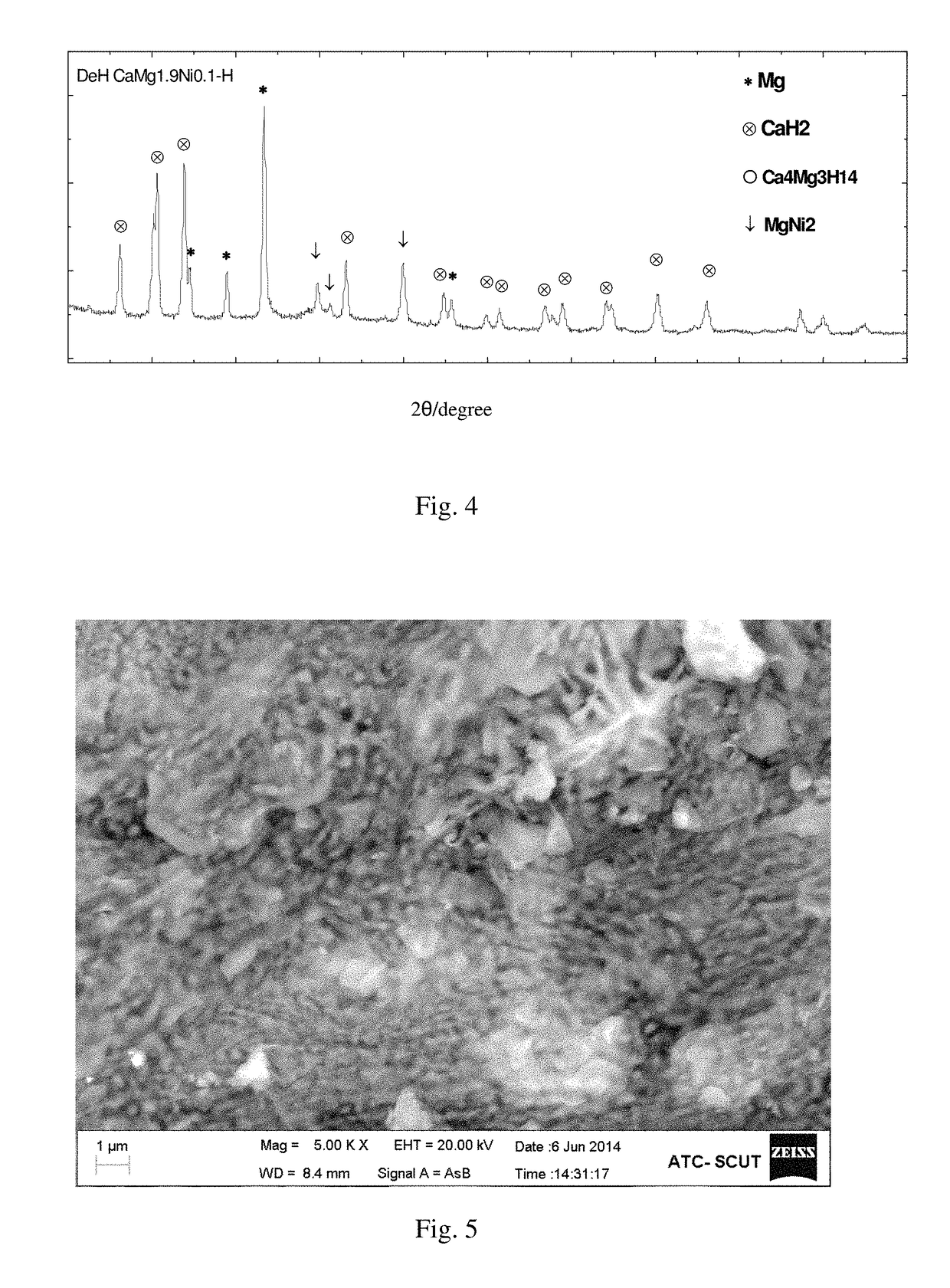CaMg2-based alloy hydride material for hydrolysis production of hydrogen, preparation method therefor and use thereof
a technology of hydride materials and camg2 alloys, applied in the direction of hydrogen production, chemistry apparatus and processes, other chemical processes, etc., can solve the problems of large increase in the amount of produced hydrogen, poor reversibility, and high hydrogen absorption temperature, so as to improve the hydrogen absorption performance of camg2 alloys, not reducing their hydrogen storage capacity, and the effect of effective hydrogen storage capacity of alloys
- Summary
- Abstract
- Description
- Claims
- Application Information
AI Technical Summary
Benefits of technology
Problems solved by technology
Method used
Image
Examples
example 1
[0040]The method for the CaMg1.9Ni0.1—H hydride comprises the following steps:
[0041]Weighing pure metals Ca, Mg and Ni (having the purity greater than 99%) at an atomic ratio of 1:1.9:0.1, with the burning loss of Ca and Mg being 7% and 6%, respectively. And then putting the weighed metals Ca, Mg and Ni in turn into a prepared crucible (provided with a vent), wherein the metal block Ni is placed at the top. Installing the crucible in a high-frequency induction melting furnace, evacuating to 5×10−3 Pa, and then introducing 0.5 atm argon gas as a protective gas. Starting the high-frequency induction melting furnace to heat at a low power for 2 to 3 min, then increasing the power to melt the alloy into a liquid and keeping for 1 min to uniformly fuse the same, and thereafter cooling with the furnace to obtain an alloy ingot, and then cooling with the furnace after remelting 2 times to obtain a hydrogen storage alloy based on CaMg2 (the X-ray diffraction pattern is shown as the curve d ...
example 2
[0042]The method for the CaMg1.8Ni0.2—H hydride comprises the following steps:
[0043]Weighing pure metals Ca, Mg and Ni (having the purity greater than 99%) at an atomic ratio of 1:1.8:0.2, with the burning loss of Ca and Mg being 7%. And then putting the weighed metals Ca, Mg and Ni in turn into a prepared crucible (provided with a vent), wherein the metal block Ni is placed at the top. Installing the crucible in a high-frequency induction melting furnace, evacuating to 5×10−3 Pa, and then introducing 0.5 atm argon gas as a protective gas. Starting the high-frequency induction melting furnace to heat at a low power for 2 to 3 min, then increasing the power to melt the alloy into a liquid and keeping for 1 min to uniformly fuse the same, and thereafter cooling with the furnace to obtain an alloy ingot, and then cooling with the furnace after remelting 2 times to obtain a hydrogen storage alloy based on CaMg2 (the X-ray diffraction pattern is shown as the curve c in FIG. 1). Removing ...
example 3
[0044]The method for the CaMg1.8Co0.2—H hydride comprises the following steps:
[0045]Weighing pure metals Ca, Mg and Co (having the purity greater than 99%) at an atomic ratio of 1:1.8:0.2, with the burning loss of Ca and Mg being 7%. And then putting the weighed metals Ca, Mg and Co in turn into a prepared crucible (provided with a vent), wherein the metal block Co is placed at the top. Installing the crucible in a high-frequency induction melting furnace, evacuating to 5×10−3 Pa, and then introducing 0.5 atm argon gas as a protective gas. Starting the high-frequency induction melting furnace to heat at a low power for 2 to 3 min, then increasing the power to melt the alloy into a liquid and keeping for 1 min to uniformly fuse the same, and thereafter cooling with the furnace to obtain an alloy ingot, and then cooling with the furnace after remelting 2 times to obtain a hydrogen storage alloy based on CaMg2 (the X-ray diffraction pattern is shown as the curve a in FIG. 1). Removing ...
PUM
| Property | Measurement | Unit |
|---|---|---|
| hydrogen pressure | aaaaa | aaaaa |
| temperature | aaaaa | aaaaa |
| pressure | aaaaa | aaaaa |
Abstract
Description
Claims
Application Information
 Login to View More
Login to View More - R&D
- Intellectual Property
- Life Sciences
- Materials
- Tech Scout
- Unparalleled Data Quality
- Higher Quality Content
- 60% Fewer Hallucinations
Browse by: Latest US Patents, China's latest patents, Technical Efficacy Thesaurus, Application Domain, Technology Topic, Popular Technical Reports.
© 2025 PatSnap. All rights reserved.Legal|Privacy policy|Modern Slavery Act Transparency Statement|Sitemap|About US| Contact US: help@patsnap.com



